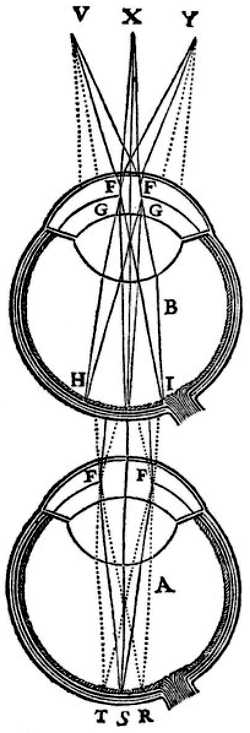Vision
Table of Contents
A painting that we see will, in our heads, always resembles the actual painting.
- This resemblance is not the cause of our feelings for the painting.
- It does not mean that we had a third eye in our brain to perceive it..
Instead, it is the movements of that impression which acts immediately against our soul (so long as it is united to our body) to create such feelings, as instituted by nature.
All the qualities which we see can be reduced to 6 principal ones:
- light
- color
- situation
- distance
- size
- shape
Light
Light and color alone belong properly to the sense of sight.
The force of the movements coming from the small threads of the optic nerves makes the soul have the sense of light.
The quality of these movements gives the soul a sense of color. This is the same way as:
- the movements of our auditory nerves makes the soul hear sounds.
- the movements of the nerves of the tongue makes the soul taste the tastes
- the movements of the nerves of the entire body makes the soul feel the sensation of tickling when they are moderate, and pain when they are too violent.
Those who receive some injury in the eye see an infinity of fires and flashes before them, even if they close their eyes.
It follows that this sensation comes from the force of the blow which moves the small nerve fibers of the optic nerve, just as a violent light would.
This same force touches the ears making us hear some sound.
Touching the body in other parts, could make us feel some pain.
How does the light move the nerves?
The light from objects varies according to:
- their distance and the size of the pupil
- the space that the rays can occupy at the back of the eye.
For example, point X would send more rays into the eye B if the pupil FF were opened up to G.

It sends just as many rays into the eye B, which is near to it and has a narrow pupil, as it does into the eye A, which is much farther away but has a much larger pupil.
Object VXY does not produce more rays from its various points that enter the back of the eye A than enter the back of the eye B.
Rather, these rays do not extend in the back of the eye A as far as they do in the back of the eye B.
This is why they must act with greater force against each of the extremities of the nerve fibers that they touch.
For example, the space HI is quadruple the size of TR. It has 4,000 small nerve fibers of the optic nerve. TR will contain only the extremities of 1,000.
Therefore, each of these nerve fibers will be moved:
- in the back of the eye
A, by the thousandth part of the forces that all the rays that enter have, taken together - in the back of the eye B, by the quarter of the thousandth part only.
One cannot distinguish the parts of bodies that one looks at, except insofar as they differ in some way in color.
The distinct vision of these colors does not depend only on the fact that all the rays that come from each point of the object are gathered together in roughly the same way in the back of the eye, and that none come from elsewhere to these same points, as has been abundantly explained already; but also on the multitude of the small nerve fibers of the optic nerve that are in the space that occupies the image at the back of the eye.
If the object VXY has 10,000 parts which send rays in 10,000 different ways to the back of the eye RST and therefore makes 10,000 colors visible.
They will not be able to distinguish more than 1,000 of them if there are only 1,000 of these nerve fibers in the space RST. This is because 10 parts of the object act together against each of these fibers.
They can only move it in a single way. And so the space that each of these fibers occupies should be considered as a single point.